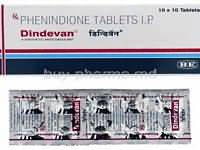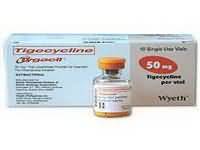Phenindione

CLINICAL USE
AnticoagulantDOSE IN NORMAL RENAL FUNCTION
Day 1: 200 mgDay 2: 100 mgMaintenance dose: 50–150 mg daily according to INRPHARMACOKINETICS
DOSE IN RENAL IMPAIRMENT
GFR (mL/MIN)
DOSE IN PATIENTS UNDERGOING RENAL REPLACEMENT THERAPIES
IMPORTANT DRUG INTERACTIONS
Potentially hazardous interactions with other drugsThere Are Many Significant Interactions With Coumarins. Prescribe With Care With Regard To The Following:Anticoagulant effect enhanced by: alcohol, amiodarone, anabolic steroids, aspirin, azithromycin, aztreonam, bicalutamide, cephalosporins, chloramphenicol, cimetidine, ciprofloxacin, clarithromycin, clopidogrel, cranberry juice, danazol, dextropropoxyphene, dipyridamole, disulfiram, erythromycin, esomeprazole, ezetimibe, fibrates, fluconazole, flutamide, fluvastatin, grapefruit juice, itraconazole, ketoconazole, levamisole, levofloxacin, macrolides, methylphenidate, metronidazole, miconazole, nalidixic acid, neomycin, norfloxacin, NSAIDs, ofloxacin, omeprazole, pantoprazole, paracetamol, penicillins, propafenone, ritonavir, rosuvastatin, SSRIs, simvastatin, sitaxentan, sulfinpyrazone, sulphonamides, tamoxifen, testosterone, tetracyclines, thyroxine, tigecycline, toremifene, tramadol, trimethoprim, valproate, voriconazoleAnticoagulant effect decreased by: acitretin, azathioprine, barbiturates, carbamazepine, griseofulvin, mercatopurine, mitotane, oral contraceptives, phenytoin, primidone, rifampicin, St John’s wort – avoid concomitant use, sucralfate, vitamin KAnticoagulant effects enhanced/reduced by: amprenavir, anion exchange resins, corticosteroids, dietary changes, tricyclicsADMINISTRATION
Reconstition
–Route
OralRate of Administration
–Comments
–OTHER INFORMATION
Titrate dose to INR Enhanced anticoagulant effect in renal impairment, due to reduced protein bindingMetabolites of phenindione often colour the urine pink or orange.
See how to identify renal failure stages according to GFR calculation
See how to diagnose irreversible renal disease
Home








